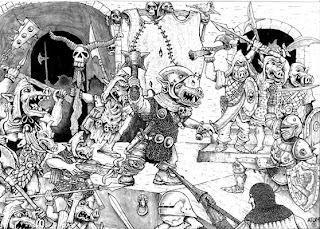BATTLESYSTEM: Rules Clarifications

Official Battlesystem Errata
(As originally printed in the Castles 3-D Boxed Set product.)Since the publication of the Second Edition Battlesystem rules, the following errata and updates have been compiled.CREATURES WITH SPECIAL ATTACK DICE
Some creatures make attacks requiring more than one die roll (AD 2d12, for example). To determine the hits for such attacks, follow these steps: roll each die individually, determine the hits caused by each die, and then add the total hits together. It is possible for a single attack to cause more than 4 hits. (The method in the Battlesystem rulebook is incorrect.)Example One: An adult copper dragon (AD 3d10) breathes on a unit of goblins. Three ten-sided dice are rolled, with results of 7, 1, and 6. According to the combat conversion table, these rolls cause hits of 2, 0, 2 The unit suffers a total of 4 hits from the attack.
Example Two: A shot fired from a trebuchet hits its target, causing AD 3d12 hits. The die rolls are 11, 8, and 5. The hits caused by each roll are 3, 2, and 1, for a total of 6 hits.
NEW MORALE MODIFIER
-2 for each additional morale check requiredWhen a unit would be required to make more than one morale check in a given step, it still only makes a single morale check. If additional checks are called for, each one becomes a -2 penalty to the check instead.
Example: A unit of light infantry (ML 11) loses its first figure to a Fireball blast. Each of these events -- first loss of a figure and loss of a figure due to magic -- would trigger a morale check. Only one check is made, but the unit checks at a ML 9, due to the -2 penalty for the second required check. A 7 is rolled and the unit becomes shaken.
MOVEMENT OF UNITS IN CONTACT
If a unit contacts the enemy, the unit cannot change facing during that turn after any figure has come into base-to-base contact with an enemy piece.Example: A unit of axemen begins the move 6" from a small band of enemy goblins. During their unit's move, the axemen expand their frontage and close to contact with the goblins. Although the unit's frontage exceeds that of the goblins (and though the unit has movement remaining), it cannot perform a wraparound maneuver this turn. To do so would require figures to change their facing; since the unit has just made contact with the goblins this turn, the move is not allowed. During the next turn, the unit can perform wraparound movement, however.
If a unit begins the move in contact with the enemy, figures that are not in contact with an enemy piece can change their facing.
A figure in contact with an enemy piece can only change its facing under two conditions: if the unit is forced to rout, or if the player elects to use flight movement.
CHARGE MOVEMENT
A unit opting to charge is not allowed free "wheeling" or changes in frontage or facing. It must still pay all movement costs for these maneuvers. These adjustments cannot exceed 3" of the unit's movement.CHARISMA MODIFIER
The Charisma Bonus Table below was accidentally omitted from the Battlesystem rulebook. This table is used when a player creates a unit's heroes and commanders. The table determines what morale modifier the commander has, if any. This morale modifer is applied to the morale check of any unit within the hero's command radius. He cannot voluntarily withhold this modifer; it is a factor of his presence.Table 16
Commander's Charisma BonusCharisma Morale Modifier 19+ +3 17-18 +2 15-16 +1 7-14 0 5-6 -1 3-4 -2 2 or less -3
Additional Battlesystem Rules
From time to time, rules for Battlesystem have been printed in various products or publications. Here is a general outline of those new rules.Additional Skirmisher Rules
In addition to the standard rules for skirmishers (see Battlesystem, pg. 54-56), the following rules were provided in Ral Partha's Bilidum and his Ogre Marauders miniatures set:Units may go from skirmish formation to regular or irregular formation, or they may change from regular or irregular formation to skirmish formation. This additional ability increases the cost of the unit by one point per man.For a unit to shift into a skirmish formation, move each figure as stated in the movement section under Skirmishers. When movement is completed, no figure's base may be closer than 1/2" to another figure's base of the same unit. Also, no single figure's base may be further than 1" distance from another figure's base, as described in the section on formation. For a unit to reform into its original formation (either regular or irreguar) a morale check must first be rolled. All modifers apply. Failure means the unit may not reform or move this turn excepting to perform a skirmisher withdrawal. If successful, the unit reforms on the center of the skirmisher's grouping in any of the permissable formations, facing any direction desired. This costs regular units 1/2 their total movement, and irregular units their full movement.
Clarification -- The movement rating of a unit out of command is not affected for the purpose of skirmisher withdrawal.
Skirmishers may be two ranks deep, and receive the appropriate benefits.



Comments
Post a Comment